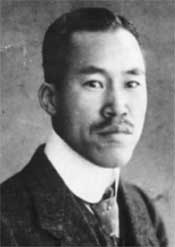Hakaru Hashimoto: 1881-1934
After making a great discovery early in his career, Hashimoto left his academic pursuits for a career as a hometown family physician.
Click Here to Manage Email Alerts
The Japan Thyroid Association uses Hakaru Hashimoto’s picture in its logo as a way to pass on his pioneering spirit to today’s physicians.
At 35, Hashimoto abandoned his short-lived academic career to return to his birthplace and take over the family practice because his family needed financial support. Word spread through the local areas that a doctor who had studied abroad was now practicing medicine locally. Hashimoto was willing to travel great distances in a rickshaw to visit patients. He put into practice the saying, “Medicine is a benevolent art.”
During his brief academic career – the nine-year span between the time he graduated medical school and his return to his hometown – Hashimoto identified a form of thyroiditis that would later be classified as the most common cause of hypothyroidism.
His life
Hashimoto was born on May 5, 1881, in the village of Midau, Nishi-tsuge in the Mie prefecture, Iga-Ueno. He was the third son in a family that had been practicing medicine for generations.
|
|
During this time the medical profession was well-respected in Japan. When Hashimoto entered the First Mie Prefectural Junior High School at Tsu, he began to think about pursuing a career in medicine. It is said that he was greatly influenced by his grandfather, Gen’I Hashimoto, a well-known doctor who had studied Dutch medicine.
In 1907, Hashimoto graduated from the Kyusyu Imperial University in Fukuoka. He was one of the first graduates of the medical school.
Between 1908 and 1912, Hashimoto took an interest in thyroid tissue while working in a surgical department. It was during this time that he extracted thyroid tissue samples from four patients and discovered new pathological characteristics.
In 1912, Hashimoto reported his findings as an independent new disease in Archiv Fur Klinishe Chirurgie, the German journal of clinical surgery. His monograph, titled Notes of lymphomatous in the thyroid gland (struma lymphomatosa), was 30 pages long with five figures. This article was his only publication on the thyroid gland. He was only 31.
Soon after the monograph was published, Hashimoto went to Germany to further pursue his research. He studied pathology under Professor Kaufman at Goettingen University; however, when World War I started Hashimoto was forced to return to Japan.
After a short time working at Kyusyu, Hashimoto returned to his hometown to work at the family practice. Although it was a modest hospital – its grounds totaling less than one acre – Hashimoto had more patients that he could handle.
Hashimoto eventually married at age 39 and had three sons and one daughter.
At age 52, he was infected with typhoid fever on one of his house calls. Hashimoto died on Jan. 9, 1934 before receiving wide recognition for the discovery of goitrous lymphocyctic thyroiditis, or Hashimoto’s disease.
The discovery
Hashimoto identified lymphocytic thyroiditis by examining tissue samples and goiters of four middle-aged women. The goiters caught his attention because unlike the colloid goiter, which was commonly found, these goiters had a preponderance of lymphoid cells. Two of the women also had hypothyroidism.
Hashimoto ruled out Graves’ disease, Ridel’s thyroiditis, Mikulicz’ disease and chronic infection as possible explanations. He was confident that this was a newly discovered disease. He named it struma lymphomatosa and emphasized infiltration of lymphoid cells and formation of lymphoid follicles with a germinal center. Neither of these had been reported previously.
The four histological characteristics that became the basis of Hashimoto’s disease were the formation of lymphoid follicles, the marked changes in the thyroid epithelial cells, the extensive formation of new connective tissue and the diffuse round cell infiltration. Hashimoto did thorough research for his monograph and defended his classification with numerous comparisons to existing diseases of the thyroid.
Occurring almost twice as often in women than in men, Hashimoto’s disease is now recognized as an autoimmune disease and the primary cause of hypothyroidism. It is characterized by invasion of the thyroid tissue by leukocytes, mainly T-lymphocytes, and is sometimes associated with non-Hodgkin lymphoma.
Earning its name
Although there was some recognition of Hashimoto’s discovery at the time of the monograph’s publication, it was very limited. He received especially limited recognition of his discovery in Japan, because many there could not read German, the language in which he chose to publish.
Hashimoto’s classification of the disease was still relatively unknown among the British and Americans by the late 1920s. Cases of “Hashimoto’s disease” were reported, but with no reference to him.
By the mid-1930s this would change. Around that time, Allen Graham, a surgeon from Cleveland, Ohio, echoed Hashimoto’s theory that lymphomatous goiter was not Riedel’s thyroiditis and was a separate disease. Soon after, Hashimoto began to be mentioned in thyroid surgery textbooks and his name was routinely attached to the disease in America. Experts began to say that the disease was “first accurately described by Hashimoto and commonly designated by his name.”
The eponym would not be reintroduced to Japan until the 1950s.
For more information:
- Amino N, Tada H, Hidaka Y, Hashimoto K. Hashimoto’s disease and Dr. Hakaru Hashimoto. Endocrine Journal. 2002;49:393-397.
- Masuda H. About the discoverer of Hashimoto’s disease. JNECM. 2005;1:237-238.
- Sawin CT. The heritage of Dr. Hakaru Hashimoto (1881-1934). Endocrine Journal. 2002;49:399-403.

